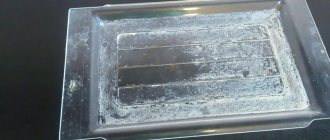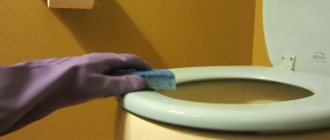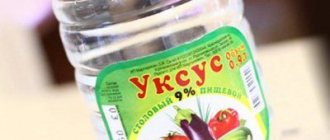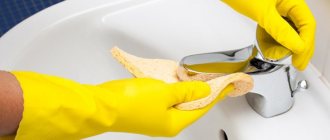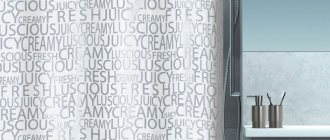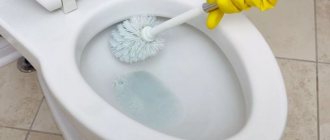Water with a high concentration of potassium and magnesium salts causes housewives a lot of trouble. It dries the skin, increases the consumption of detergents, forms sediment that is deposited on the walls of the pipes, and damages the heating elements.
When a bathtub comes into contact with such water, it becomes covered with limescale. To combat it, a soap solution and a rag are not enough.
We'll tell you how to clean limescale in the bathroom at home in this article.
How to remove limescale in the bathroom: choosing a product, preparing for cleaning
Limescale inevitably appears on plumbing items: faucets, toilets, sinks and, of course, bathtubs. The reason for this phenomenon is hard running water, which contains a lot of calcium and sodium salts. The binding element is fatty particles that enter the water during washing. Such deposits settle firmly on surfaces and are almost impossible to clean with water and regular soap.
To remove limescale in the bathroom quickly and without problems, you should know a couple of tricks when working with different coatings and products:
- Even if the surface allows the use of low-abrasive powders, it is better to turn them into a paste by pouring a little water into the bottom of the bath. This way, less dust will fly from the powder, and the effect on the enamel will be more delicate.
- Plaque should be removed from an acrylic bathtub carefully; the use of coarse abrasives, chlorine-containing and acidic cleaners is prohibited. There are special soft gels on sale: they protect acrylic, removing dirt and plaque without consequences.
- It is better to exclude aggressive agents based on sulfuric and nitric acid or reserve them for particularly difficult cases and tough coatings.
- For mechanical impact even on the strongest growths, only soft brushes and sponges are used, but not metal scrapers, wire sponges, sandpaper and similar rough objects. They will ruin even the most durable bathing containers, not to mention acrylic ones. Scratches, and especially holes, quickly accumulate dirt on surfaces, bacteria develop, and black mold appears.
- Plaque accumulates on plumbing fixtures gradually, moving from the film stage to the stage of voluminous, rough growths. “Water stone” - age-related lime deposits - adheres tightly to surfaces and has a high density, so it is practically impossible to remove it without damaging the enamel. This is why it is so important to regularly care for your plumbing fixtures.
- Industrial products based on alkaline and organic solvents can be used, however, when working with such chemicals, several rules must be followed. First, bleach only light-colored cast iron or steel bathtubs if their enamel is not older than 15-20 years. Secondly, be sure to use protective gloves and ventilate the room.
- Industrial gels do not need to be rubbed in; it is enough to distribute them evenly.
- Terry cloths and microfiber are used for the final cleaning step. They gently polish and erase minor dirt.
- After cleaning, it is not enough to simply rinse the bathtub or sink: it is recommended to fill the container with cool water and then drain it. This will remove all traces of limescale and cleaning agent.
- The thinner and more sensitive the coating, the more often it needs to be washed. For example, for acrylic bathtubs, the frequency of procedures is 1-2 times a week, if it is filled regularly. If it is not customary for the family to bathe, only take a shower, then general cleaning is enough to carry out 1-2 times a month.
The stronger the enamel, the easier it is to remove limescale from it: strong mechanical impact, the use of small abrasives, and aggressive industrial products, such as Domestos, are allowed. If the plumbing fixtures are quite fragile, you will have to use gentle store-bought and folk methods. It’s good that many of the tools are at hand and can be found at any housewife.
What is not recommended by manufacturers?
Application for acrylic bath products:
Powdery and abrasive. Microdamages remain on the surface, due to which over time the surface will become dull and acquire a gray tint.- Chlorine-containing. The bath bowl becomes cloudy, the structure of the coating is damaged, and it becomes porous.
- With acetone, solvent, ammonia. They destroy the surface, the bath loses its shine and darkens.
For the same reasons, long-term contact with chlorine, gasoline, and alcohol is contraindicated for acrylic products.
For steel and cast iron products coated with enamel, there are restrictions:
- The use of products containing strong acids (sulfuric, hydrochloric, oxalic, etc.).
- Prolonged contact with chlorine-containing solutions.
- Using metal, hard brushes and sponges.
All of the above can damage the protective layer of enamel or destroy its structure. This will affect the appearance of the bowl and intensify the process of deposition of dirt and plaque on the surface.
Method 3: citric acid
This cleaning method is suitable for all surfaces, including acrylic and plastic. To work, you will need 2-3 packs of citric acid and a soft sponge.
Important: The product is applied to contaminants in the form of a solution; the acid granules are a fine abrasive.
How to clean plumbing fixtures with citric acid solution:
- For a packet of citric acid - 2 cups of water. Dilute the powder and stir until dissolved.
- Using a sponge, apply the solution to all surfaces.
- Repeat the treatment twice with an interval of 20 minutes.
- Once the desired cleanliness is achieved, rinse the bathtub or sink thoroughly with cold water.
Method of using citric acid on an acrylic bathtub:
- Fill the bath with cool water so that all traces of plaque are hidden.
- Add a pack of citric acid.
- Leave for 12 hours.
- Drain the solution and rinse the bath with running water, then wipe dry with a cloth.
How to remove old plaque
To combat old lime deposits, you will need professional household chemicals with a strong composition. For example, L.O.S. from Amway, Sanox with Poli-Gel cleaning enhancer.
Or use this budget cleaner recipe:
- mix Pemolux or soda with water to a mushy consistency;
- add 20 ml of bleach and 30 ml of 9% vinegar, mix well;
- treat problem areas and leave the product for 30 minutes;
- when the plaque begins to come off, rub the surface with a sponge;
- Rinse thoroughly with water and wipe the plumbing fixtures dry.
Wear rubber gloves. Also, do not forget to protect your airways with a respirator. After cleaning, ventilate the room.
Do not use aggressive solvents, acetone or gasoline for cleaning. They spoil the appearance of the coating. Rough brushes and sponges should also be put away - they can leave scratches, which will aggravate the deposition of lime. If you can’t get rid of stains, contact professionals: they will select special surface cleaning products that are safe for the coating.
Method 4: “Whiteness”
Deposits can be removed with this product only on cast iron bathtubs. Bleach is aggressive, so it is used diluted even on the toughest surfaces.
How to clean cast iron with “Whiteness”:
- Prepare a mixture of 1 tbsp. l. bleach, 2 tbsp. l. vinegar and a small amount of powder, diluted with water to a paste.
- Apply cleaning paste to areas with plaque using a rubber spatula.
- For the product to work, you need to wait 15-20 minutes.
- Use the hard side of the sponge to wipe away deposits. The plaque comes off, all that remains is to wash it off with detergent and wipe the bathtub dry.
Features of materials
Modern bathtubs are made from different materials: cast iron, steel, acrylic, enamel. Accordingly, they need a different approach.
If you are going to use something completely new to clean limescale, test the product first in an inconspicuous area.
Each material has its own characteristics:
- Acrylic bathtub is sensitive to hard abrasives, brushes, and caustic substances. It scratches easily and may lose its gloss. For cleaning, special liquid and gel products, soft brushes, and wipes are recommended. The exposure time cannot be increased. The jar must be marked “suitable for acrylic bathtubs.”
- An enamel bathtub is easier to clean from limescale. You can use various cleaning powders, store-bought products with acids, surfactants, sodium hypochlorite, brushes and hard sponges. Metal scrapers and caustic alkalis and acids not intended for cleaning plumbing equipment are prohibited.
- A cast-iron bathtub retains heat well, does not deform, and absorbs the noise of rising water. Usually the enamel on it is strong and thick. It's difficult to damage it.
- A steel bathtub is considered the strongest. But at the same time, the market is full of low-quality steel bathtubs - thin, with poor coating. It is better to clean a cheap steel bathtub from limescale in the same way as an acrylic one.
Method 7: Cleaning Plumbing and Pipes with Vinegar
When plaque covers chrome surfaces, table vinegar comes to the rescue:
- Dilute vinegar with warm water in equal proportions.
- Moisten a piece of cloth with the solution and cover the tap with it, securing with an elastic band if necessary.
- Leave for 2-4 hours.
- Removable items should be soaked in the solution for half an hour.
- Rinse with clean water, removing any loose deposits with a piece of cloth.
- Wipe dry.
How to avoid large plaque accumulations
First, you need to clean your bathtub more often. If the water is hard, lime will settle on the walls one way or another.
These tips will help you resort to global measures as little as possible:
- After each wash, rinse the bathtub with warm, clean water. It is necessary to wash off all organic residues and particles of shampoo, shower gel and other products.
- Install a special water filter on the tap. This measure will not only preserve the plumbing for many years, but will also make the water safer for washing.
- Soak items and wash them in separate containers.
- If there is deposits in the toilet, eliminate the leakage from the tank. The same applies to faulty taps.
- Excessively hot water is harmful for a bathtub, especially an acrylic one, so do not pour boiling water into the container, open the cold valve first, and close it last.
- Cracks accelerate the appearance of dirt and plaque, so when caring for surfaces, avoid hard brushes and powders with hard granules if possible.
Prevention measures
Plaque forms when water dries out. You can fight it by wiping the walls of the bathtub dry every time after a shower. However, this is a labor-intensive process, and there is not always time to complete it. It is better to choose effective chemicals and periodically clean the bathtub before a permanent deposit forms. For prevention, the bathtub is treated with a glass cleaner, since it contains a small amount of ammonia. After treatment, you must wait 20 minutes, then rinse off the substance.
You don't need to use glass cleaner every day to prevent stains. It is enough to clean once every 3-5 days or once a week if the water contains fewer aggressive components and dirt slowly lingers on the walls of the bathtub.
Bathroom cleaning trick
After washing, spread a small amount of glass cleaning spray onto a clean surface. The product contains ammonia, which neutralizes barely noticeable limescale deposits. The spray should be washed off after 20-30 minutes.
A large bathtub can be cleaned in 5-15 minutes with industrial gels - it’s quick, but labor-intensive. Gentle products should be left on the walls - while the lime acidifies, you have time to rest or do other things, just don’t forget to close the door to the bathroom and warn your household that it is not yet possible to pour water into the bathing container.
A clean bathroom is necessary not only for comfort, but also for maintaining health. The lime layer can be easily removed if you do not let the situation take its course and rinse after each use. Fighting limescale build-up won’t take much time either, the main thing is to choose the right product.
Where does plaque come from?
When surfaces come into constant contact with liquids, limestone builds up. This is the name for specific contamination that occurs on any coating, but on the walls of the bathtub the likelihood of this is much higher, since the plumbing fixture is in use every day.
Plaque occurs due to the composition of the liquid. Excess calcium and magnesium salts have a greater effect on the formation of contaminants. The presence of iron causes the enamel to turn yellow.
Additionally, soap scum appears in the bathroom. This is the result of a combination of tap water and soap. Due to the presence of fatty components in the liquid that is washed off after taking a shower, dirt lingers in the bathroom faster. The plaque becomes denser and gradually turns into hard stone deposits. It is impossible to remove them with water.
Signs of limescale deposits on plastic and enamel in the bathroom:
- gray or yellow stains;
- contaminants cannot be removed with water;
- the surface becomes rough.


